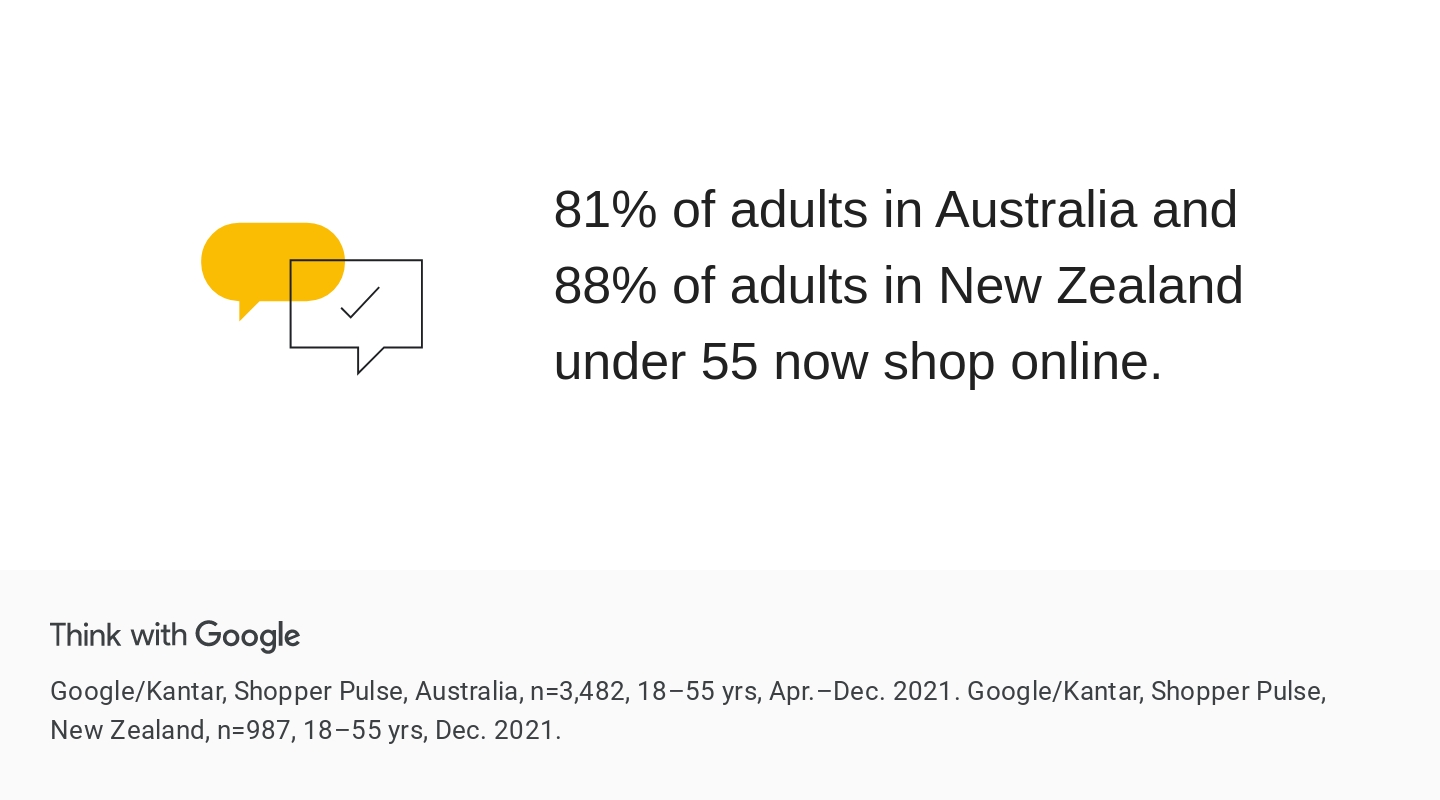With consumers now embracing the digital-first lifestyle, brands should consider how they can move from COVID-proofing to future-proofing, in order to realise future opportunities through agility, confidence, and clarity.
Throughout the pandemic, we’ve seen significant growth in online shopping. And even though we’re out and about again, spending has continued and doesn’t look like it’s stopping any time soon. No question, cash registers will be ringing for the remainder of this year and next. But just how will they be ringing up sales now and into the future?
Pandemic Behaviours Sticking Around
For two consecutive years, Australians have made more transactions online than in-store over the busiest shopping periods(1). Little surprise, then, the vast majority of Australian and New Zealand adults under the age of 55 now shop online(2).
Importantly, the top-end of that cohort (people in their forties and fifties) have significantly increased their online spending(3). Yes, the pandemic played its part, but even with bricks-and-mortar stores opening back up, the growth has continued. What’s more, during the recent peak season (October through January 2022), nine in ten retail dollars spent offline were influenced by digital(4).
“Millennials and Gen Z are digital natives – they’ve always been comfortable shopping online,” says Renee Gamble, Director of Commerce for Google Australia New Zealand. “But throughout the pandemic, we’ve seen significant growth in online purchasing by adults all the way up to the top of the important under-55 cohort. And this has sustained, even with physical stores opening back up.”
And it’s not just that they’re using digital channels to shop more, they’re using the same ones differently.
“The way they use Search online is a great example,” says Gamble. “Australians are no longer just using Google Search at the pointy end of their shopping journeys. One in two Australians under 55 are using Search to research initial ideas of what they might need, and this behaviour is continuing to increase(5).
“People are exploring and evaluating online – meaning online touchpoints like search can be just as effective at driving discovery and awareness as driving action. So consider how you use digital to help shoppers find your brand anywhere, at any time.”
But don’t rush to pull down the shutters on your shopfront just yet. While dollars spent offline are influenced by digital, the Australian Bureau of Statistics (ABS) reported that just under 85 per cent of non-food related retail sales throughout the year still happen in a physical store(6).
What has changed, however, is how customers arrive at the point of purchase – regardless of whether the final transaction is done online or in person.
Bricks and Clicks
Australians and New Zealanders have realised it just makes so much sense to do their research online and at a time that suits them. Importantly, more than half of all retail searches in Australia and New Zealand happen outside nine-to-five(7).
If you’re not offering them something to discover when your store’s doors are bolted shut, you’re missing out.
YouTube has become a de facto channel for Australian and New Zealand shoppers to understand a product’s size, shape and functionality, while Search lets them quickly identify where a product can be purchased and picked up or delivered.
“Where people used to go into physical stores to assess the size and shape of products, now they can watch unboxing or review videos on YouTube to do the same thing,” explains Gamble. “Where they used to check the shelves of their local store to see what was in stock, now they can check availability online and arrange click and collect.”
Omnichannel, so long a buzzword around the world, has absolutely reached maturity.
Digital Strategies To Adopt Today
“Australians and New Zealanders love shopping in-store, but stores are now a physical touchpoint in multi-channel consumer journeys,” says Gamble. “But rather than being a challenge to the store’s existence, digital’s ability to influence store interactions presents a great opportunity for brands.”
In the ‘Realise Commerce Everywhere’ campaign, research points to the urgency with which brands must adopt omnichannel maturity.
For many businesses, marketing based on yearly plans no longer make sense.
Rather than viewing e-commerce and the store as two separate pathways, brands should now be considering how they can use their online presence to drive sales in-store.
Start by investing in first-party data and measurement to build a detailed understanding of your customers; how they shop, their motivations, their journeys, and what they’re doing online and offline.
Then, embrace new capabilities through automation that allows you to stay responsive even when the pace of change is hard to keep up with.
By doing this, you’ll build a digital foundation for your business that’s reliable, agile, and – most importantly – future proof your business.
“So if you’re still rethinking your marketing approach, now is the time to put thought into action. It’s time to realise commerce everywhere,” concludes Gamble.
(1) Source: Google / Ipsos, Omnichannel Holiday Study, online survey, n=3158 online Australians 18+ who shopped in the past two days, Oct 28, 2021 – Jan 5, 2022.
(2) Google/ Kantar, Shopper Pulse Australia, April to December 2021, 18-55yrs, n=3,482. Google/ Kantar, Shopper Pulse New Zealand, December 2021, 18-55yrs, n=987.
(3) Google/ Kantar, Shopper Pulse Australia, April to December 2021, 18-55yrs, n=3,482. Google/ Kantar, Shopper Pulse New Zealand, December 2021, 18-55yrs, n=987.
(4) Source: Google / Ipsos, Omnichannel Holiday Study, online survey, n=3158 online Australians 18+ who shopped in the past two days, Oct 28, 2021 – Jan 5, 2022.
(5) Source: Google/ Kantar, Shopper Pulse, Australia, n=3,169 18-55yrs, April – December 2021.
(6) Source: ABS, Retail Trade, Australia, December 2021.
(7) Source: Google Internal Data, Australia and New Zealand, 1 Jan – 20 Feb 2022, searches related to retail categories (Beauty & Personal Care, Hobbies & Leisure, Sports & Fitness, Apparel, Computers & Consumer Electronics, Home & Garden, Food & Groceries, Retailers & General Merchandise).













